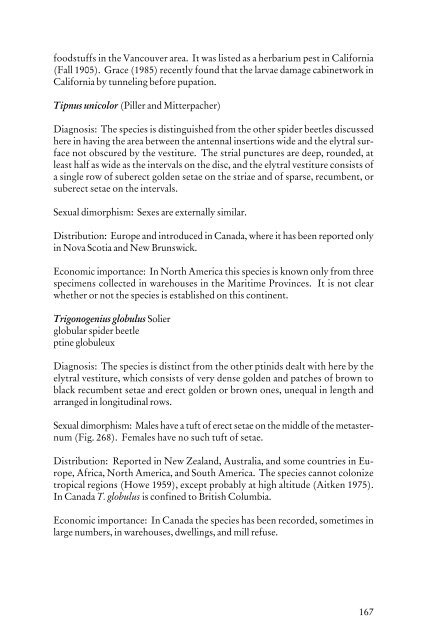Beetles Identification Guide
Beetles Identification Guide
Beetles Identification Guide
You also want an ePaper? Increase the reach of your titles
YUMPU automatically turns print PDFs into web optimized ePapers that Google loves.
foodstuffs in the Vancouver area. It was listed as a herbarium pest in California<br />
(Fall 1905). Grace (1985) recently found that the larvae damage cabinetwork in<br />
California by tunneling before pupation.<br />
Tipnus unicolor (Piller and Mitterpacher)<br />
Diagnosis: The species is distinguished from the other spider beetles discussed<br />
here in having the area between the antennal insertions wide and the elytral surface<br />
not obscured by the vestiture. The strial punctures are deep, rounded, at<br />
least half as wide as the intervals on the disc, and the elytral vestiture consists of<br />
a single row of suberect golden setae on the striae and of sparse, recumbent, or<br />
suberect setae on the intervals.<br />
Sexual dimorphism: Sexes are externally similar.<br />
Distribution: Europe and introduced in Canada, where it has been reported only<br />
in Nova Scotia and New Brunswick.<br />
Economic importance: In North America this species is known only from three<br />
specimens collected in warehouses in the Maritime Provinces. It is not clear<br />
whether or not the species is established on this continent.<br />
Trigonogenius globulus Solier<br />
globular spider beetle<br />
ptine globuleux<br />
Diagnosis: The species is distinct from the other ptinids dealt with here by the<br />
elytral vestiture, which consists of very dense golden and patches of brown to<br />
black recumbent setae and erect golden or brown ones, unequal in length and<br />
arranged in longitudinal rows.<br />
Sexual dimorphism: Males have a tuft of erect setae on the middle of the metasternum<br />
(Fig. 268). Females have no such tuft of setae.<br />
Distribution: Reported in New Zealand, Australia, and some countries in Europe,<br />
Africa, North America, and South America. The species cannot colonize<br />
tropical regions (Howe 1959), except probably at high altitude (Aitken 1975).<br />
In Canada T. globulus is confined to British Columbia.<br />
Economic importance: In Canada the species has been recorded, sometimes in<br />
large numbers, in warehouses, dwellings, and mill refuse.<br />
167
















